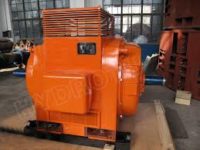Excitation of Synchronous Generator
In this article we will know about the excitation of synchronous generator . We will studied about the dc exiters and brush less excitation static excitation . From this article we will also know about the working of sysnchronous generator.
Excitation of Synchronous Generator
Now we are going to discuss about teh excitation of synchronous generator
The Various schemes used for exciting large synchronous generators are

-
D.C. Exciters
This is an old conventional method of exciting the field windings of synchronous generators.
In these method three machines, namely pilot exciter, main exciter and the main 3-phase alternator are mechanically coupled and are therefore driven by the same shaft. The pilot exciter is a dc shunt generator feeding the field winding of a main exciter. The main exciter is a separately excited dc generator. The dc output from the main exciter is given to the field winding of the main alternator through brushes and slip rings.
The conventional method of excitation suffers from cooling and maintenance problems associated with slip rings, brushes and commentators as the alternator-rating rise. It is basic method of excitation of synchronous generator.
-
Static excitation
In this method, the excitation power for the main alternator field is drawn from output terminals of the main 3-phase alternator. For this purpose, a 3- phase transformer TR steps down the alternator voltage to the desired value. This 3-phase voltage is fed to the 3-phase full-converter bridge using thyristors. The firing angle of these thyristors is controlled by means of a regulator which picks up the signal from alternator terminals through potential transformer PT and current transformer CT. the controlled power output from thyristor unit is delivered to the field winding of main alternator through brushes and slip rings.
For initiating the process of static excitation, first of all, field winding is switched on to the station battery bank to establish the field current in alternator. The alternator speed is adjusted to rated speed. After the output voltage from alternator has built up sufficiently, the alternator field winding is disconnected from battery bank and is switched on to the thyristor bridge output. This is also a type of excitation of synchronous generator.
-
Brushless excitation
This method of excitation is illustrated. In this scheme, main shaft of prime mover derives pilot exciter, main exciter and the main alternator. Silicon diode rectifiers are also mounted on the main shaft.
Pilot exciter is a permanent-magnet alternator with permananent-magnet poles on the rotor and three-phase armature winding on the stator. Three-phase power from pilot exciter is fed to thyristor-controlled bridge placed on the floor. After rectification, the controlled dc output is supplied to stationary field winding main exciter. The three-phase power, developed in the rotor of main exciter is fed through hollow shaft to the rotating silicon-diode rectifier mouted on the same shaft. The dc power from diode Rectifier Bridge is delivered, along the main hollow shaft, to the main alternator field without brushes and slip rings.
A signal, picked from alternator terminals through CT and PT, controls the firing angle of Thyristor Bridge. This enables the controls of field current of the main exciter, which eventually governs the alternator output voltage. Since the scheme depicted. Does not require any sliding contacts and brushes, this arrangement of exciting the synchronous machine has come to called as brushes excitation system. It is also a method of excitation of synchronous generator.

Synchronous Generator Working
After studied excitation of synchronous generator we will study about the synchronous generator wirking.
AC system has a number of advantages over DC system. These day 3-phase AC system is being exclusively used for generation, transmission and distribution of power. The machine which produces 3-phase power from mechanical power is called an alternator or synchronous generator. Alternators are the primary source of all the electrical energy we consume. These machines are the largest energy converters found in the world. They convert mechanical energy into AC energy.
Hence These are some method of excitation of synchronous generator. From this article we have studied about the wokring of synchronous generator.
